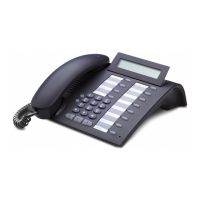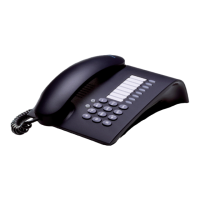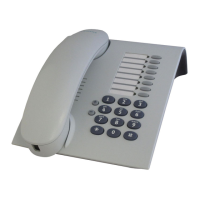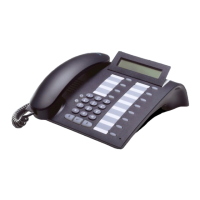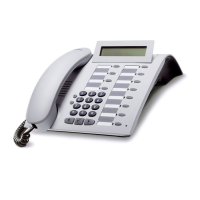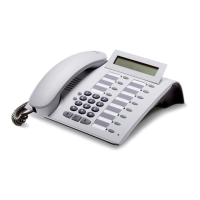Do you have a question about the Siemens optiPoint 410 entry and is the answer not in the manual?
General safety warnings for operating the telephone.
Guidelines on telephone placement and cleaning procedures.
Explains CE mark, ISO 14001, and product disposal information.
Explains the manual's purpose and intended audience.
Explains icons, symbols, and key information indicators used.
Describes basic operations like lifting handset and conducting calls.
Details intended use, product identification, and service contacts.
Lists network requirements and connection instructions.
Details connectors on the bottom of the telephone for different models.
Step-by-step guide for powering on the phone.
Explains mini-switch operation and Power over LAN support.
Outlines the phone's startup process flowchart.
Compares features and describes telephone modes (Single/MultiLine).
Identifies components and keys on the phone's control panel.
Explains the phone's display and navigation key functions.
Details the functions of the phone's dialling keypad.
Explains how to assign functions to programmable keys.
Describes the function of volume adjustment and other control keys.
Lists supported protocols and outlines phone capabilities.
Details speech support, codecs, and available call features.
Explains DTMF signaling mechanisms used by the phone.
Explains the SIP protocol used for establishing sessions in IP networks.
Covers protocols like DHCP, DNS, SNTP, and SNMP.
Details routing and Virtual LAN (VLAN) configuration.
Explains VLAN configuration options and discovery methods.
Describes the HiPath Deployment Service for workpoint administration.
Explains how QoS prioritizes network traffic for improved performance.
Describes direct configuration using the phone's keypad.
Describes remote configuration via a web browser.
Guides for accessing phone administration and diagnostic menus.
Outlines essential parameters for initial phone setup via DHCP.
Explains manual network configuration when DHCP is unavailable.
Covers IP addressing, routing, DNS, VLANs, and QoS settings.
Details SIP-specific settings like routing, proxy, server, and realm.
Procedures for software updates, file transfers, and FTP server setup.
Includes SNMP, speech, ringer settings, phone info, and diagnostic tests.
Guides for restarting the phone and restoring factory settings.
Manages passwords, user data, port control, and network survivability.
Manages phone configuration and software deployment via Broadsoft server.
Describes configuration file structure and template file usage.
Provides an example of specific configuration settings.
Example configuration for shared call appearances.
Details Sylantro's call park, pickup, and conference configurations.
Configuration for centralized conferencing and line keys.
Connecting to the phone and accessing admin/diagnostic menus.
Configuring IP, routing, DNS, VLAN, QoS, and SIP parameters.
Managing function keys, dial plans, DSS, features, and user mobility.
Configuring system settings, file transfers, SNMP, and diagnostics.
Presents the phone's menu hierarchy and options.
Details various editors like Text, Switch, Number, and Password editors.
Explains core functions like Action on Submit and Address Book.
Covers changing admin password and setting alert indications.
Details filename for application download and audio codec selection.
Explains codec selection and bandwidth requirements for calls.
Manages configuration updates, FTP settings, and file formats.
Configures DHCP for network setup and defines call routing rules.
Procedures for downloading software, configurations, and hold music files.
Settings for DSM firmware, logos, and DSS configurations.
Manages feature access and configures FTP access.
Configures hot line settings and initial digit timer.
Settings for IP routing and Java proxy servers.
Configures QoS for layers 2/3 and LAN port settings.
Views last restart info and configures LDAP server/port.
Configures line key operation and various line properties.
Settings for logoff traps, MAC address, and managed profiles.
Configures VLAN ID and mobility features.
Configuration for outbound proxy routing and PC port settings.
Controls ports, primary DNS, and QDC server/port settings.
Configuration for SIP addresses and auto answer settings.
Configures SIP routing and server type.
SNMP settings and survivability backup configurations.
Settings for terminal hostname, IP address, and subnet mask.
Configures terminating line preference and time zone offset.
Discusses common issues like no network, DHCP, and SIP errors.
Lists the default configuration settings for various functions.
| Connectivity | Ethernet |
|---|---|
| Type | Digital Telephone |
| Display | 2-line LCD |
| Audio | Handset, Speakerphone |
| Power Supply | Power over Ethernet (PoE) |
| Headset Port | Yes |
| Supported Protocols | SIP |
